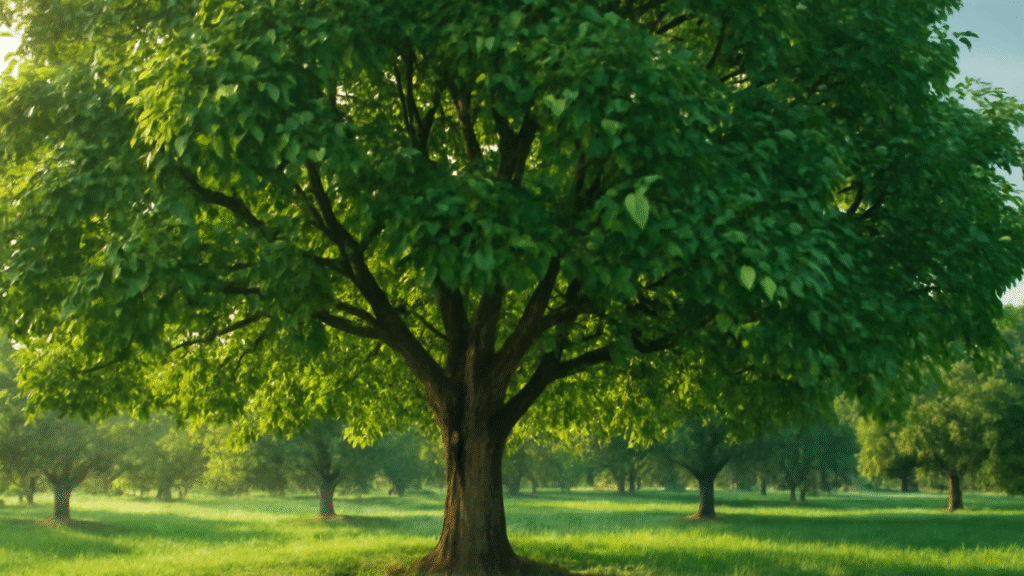
Do Walnut Trees Produce Every Year? Understanding Walnut Tree Production Cycles and How to Maximize Your Harvest
Have you ever eagerly watched your walnut tree, only to wonder why it’s bursting with nuts one year and nearly bare the next? If you’ve found yourself asking, “do walnut trees produce every year?”—you’re not alone. Many gardeners and orchard owners are puzzled by the unpredictable harvests of these majestic trees. 🌳
Understanding why walnut trees don’t always deliver a consistent crop can feel frustrating, especially when you’re putting in the effort year after year. The good news? There are real, science-backed reasons behind this pattern—and practical steps you can take to encourage more reliable yields.

In this article, we’ll demystify the walnut tree’s natural production cycles, explain what causes those “off years,” and share proven strategies to help you maximize your harvest. Whether you’re a beginner or a seasoned grower, you’ll discover actionable tips to nurture healthier trees and enjoy more abundant harvests. Ready to unlock the secrets of consistent walnut production? Let’s get started!
Table of Contents
Toggle🌳 Understanding Walnut Tree Growth and Lifecycle 🌳
If you’re considering growing walnut trees or already have them in your garden, understanding their growth cycle is crucial for ensuring a successful harvest. Walnut trees are not just beautiful additions to your landscape; they’re also hardworking plants that require proper care to produce fruit consistently. In this section, we’ll break down the growth stages of walnut trees, making it easier for you to nurture them through their lifecycle. 🌱

🌿 What Are Walnut Trees? 🌿
Walnut trees (Juglans species) are deciduous trees that thrive in temperate climates. They can reach impressive heights, with some species growing over 100 feet tall! 🌳 There are two common types of walnut trees:
- English Walnut (Juglans regia): Known for its sweet, edible nuts 🌰, it’s the most commonly grown variety in the U.S. 🍂
- Black Walnut (Juglans nigra): This type produces a more robust, bitter-tasting nut 🥜 and is often used for timber.
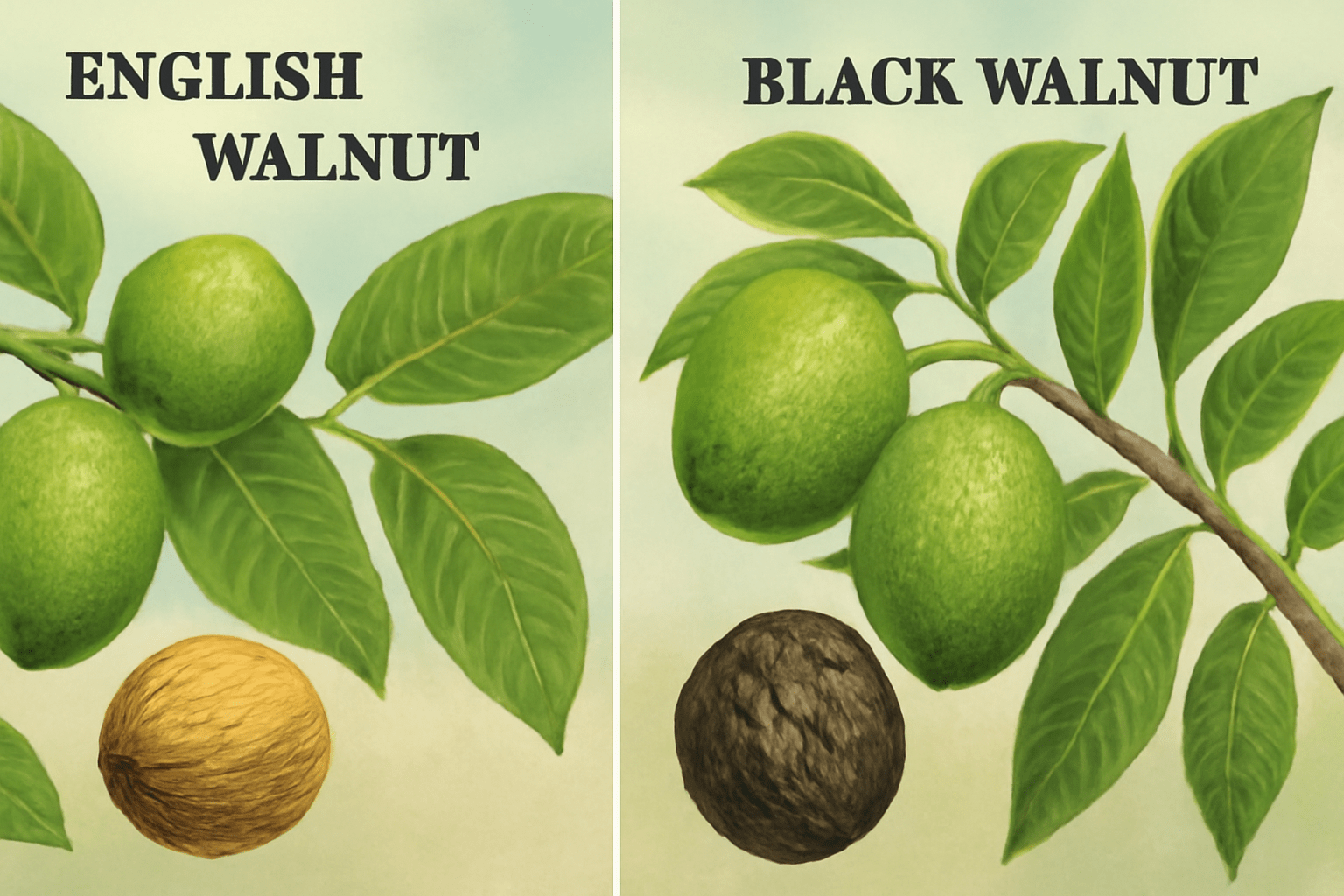
Regardless of the type, walnut trees are cherished for their deep, rich wood 🌳 and the delicious nuts they produce. 🌰
🌱 The Walnut Tree Growth Cycle 🌱
Understanding the growth cycle of a walnut tree helps you know when to expect your first harvest 🏡 and how to care for the tree in each phase. Here’s a breakdown:
❄️ Dormancy (Winter) ❄️
In winter, walnut trees enter a period of dormancy 😴. This is when the tree “rests” and conserves energy ⚡, typically from late fall to early spring.
During this phase, it’s essential to protect your tree from frost 🌨️, as it can damage buds 🌱 and affect the next year’s growth. ❌
🌸 Bud Break and Leaf Growth (Early Spring) 🌸
As the temperatures warm in spring 🌷, walnut trees start to come out of dormancy. Buds begin to swell 🍃, and the tree starts producing new leaves 🌿.
At this stage, the tree requires consistent watering 💧 and nutrients 🍽️ to support healthy leaf growth. 🌞
🌼 Flowering and Pollination (Late Spring) 🌼
Walnut trees are monoecious 🌳, meaning they have both male (pollen-producing) and female (flower-producing) flowers on the same tree. 🌺
The male flowers, known as catkins 🌿, release pollen 🌬️ that fertilizes the female flowers 🌸, which later develop into walnuts 🌰.
This is where proper pollination is key 🔑 to a good harvest. If the tree doesn’t have a suitable pollen source nearby, it may not produce nuts 😞.
🌞 Nut Development (Summer) 🌞
After successful pollination 🌻, the walnut tree begins to develop its nuts 🌰. This process can take several months, from early summer to late fall. 🍁

During this phase, the tree is very sensitive to environmental factors like temperature 🌡️, rainfall 🌧️, and soil nutrients 🌾. If the tree doesn’t receive enough water 💦 or has nutrient deficiencies 🍂, it might not develop full-sized, healthy walnuts 🌰.
🍂 Maturation and Harvest (Fall) 🍂
By late summer to early fall 🍁, the walnuts have matured. The outer hulls of the walnuts turn green 🟩 and begin to crack open 🥜.
This is the time to harvest your walnuts! Timing is crucial ⏰ because harvesting too early or too late can impact the quality of the nuts 🍽️.
⏳ How Long Does It Take for Walnut Trees to Start Producing? ⏳
Walnut trees don’t start producing nuts immediately ⏳. Here’s a general timeline:
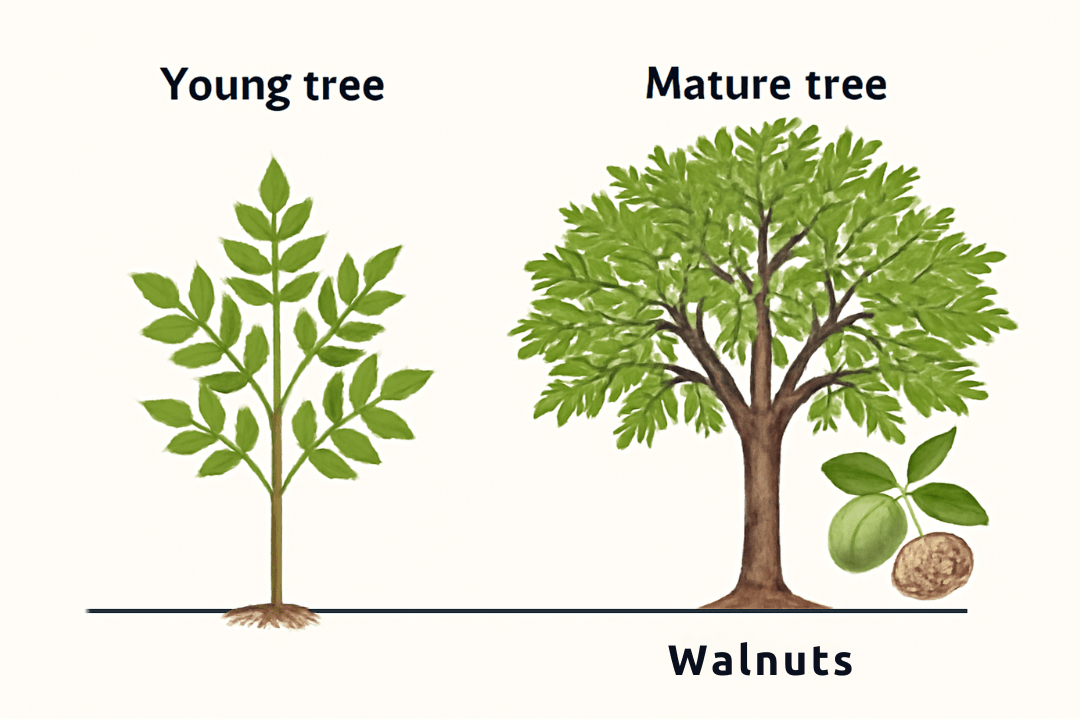
- Grafted Trees: These trees usually start bearing fruit in 5-7 years. Grafted trees tend to grow faster ⏩ and bear fruit earlier than seedlings 🌱.
- Seedling Trees: If you’re growing walnut trees from seeds 🌰, expect to wait around 10-15 years ⏳ before they start producing nuts. These trees grow more slowly 🐢 and take longer to mature.
This is why patience is key 🕰️ when growing walnut trees 🌳. 🌰
By understanding the walnut tree’s growth cycle, you’ll be better prepared to care for your trees throughout their life stages 🌿. With the right care 💧, your walnut trees can thrive 🌳, producing delicious, high-quality nuts year after year! 😊
🌰 Do Walnut Trees Produce Every Year? 🌰
One of the most common questions for anyone growing walnut trees is: “Do walnut trees produce every year?” The short answer is no—walnut trees do not always produce nuts every year. However, there are several factors that influence whether your tree will bear fruit annually. In this section, we’ll break down the key reasons walnut trees might skip a year and what you can do to encourage a consistent harvest. 🌿
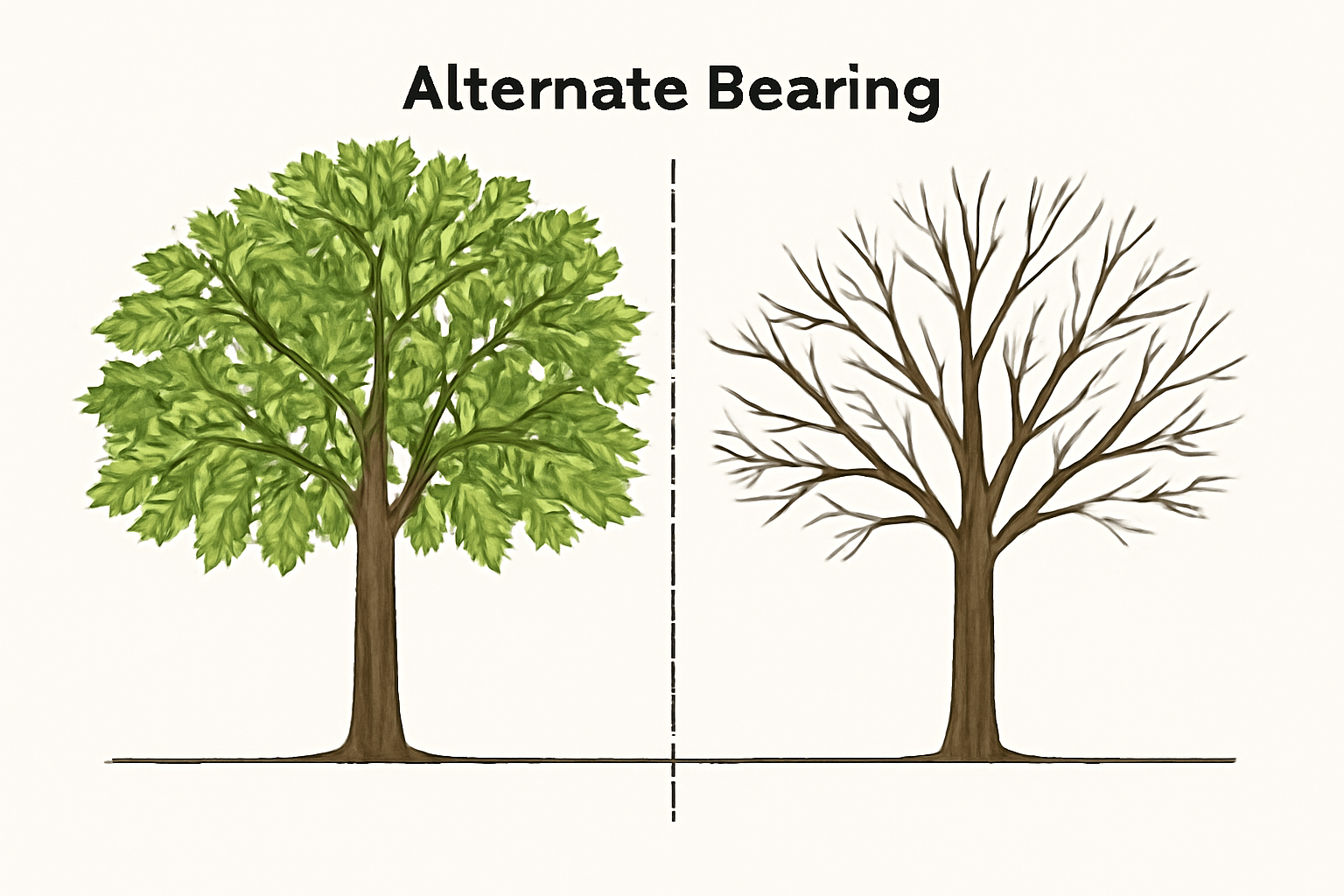
🌿 Factors That Affect Walnut Tree Production 🌿
Several factors come into play when it comes to walnut tree production. Understanding these can help you identify why your walnut tree may not produce every year—and what you can do about it. Here’s what you need to know:
🌱 Age of the Tree 🌱:
- Young Trees: If your walnut tree is still young, it may not produce any nuts just yet. As mentioned earlier, grafted walnut trees can start producing in 5–7 years, while seedling trees may take much longer (10–15 years). If your tree is still in its early growth stages, patience is key. ⏳
- Mature Trees: Once walnut trees reach maturity, they are more likely to produce nuts regularly, but even mature trees may skip a year occasionally due to other factors. 🌳
🌦️ Climate Conditions 🌦️:
Walnut trees thrive in temperate climates. However, weather conditions play a significant role in whether or not your tree will produce every year. Excessive heat 🌞 or frost ❄️ can negatively impact the flowering process and pollination, reducing or even eliminating nut production for that year.
Cold snaps in the spring can freeze the early flowers 🌸, preventing successful pollination and leading to a poor or non-existent harvest. Conversely, hot, dry conditions in the summer ☀️ can stress the tree, affecting nut development. 🌰
🌸 Pollination 🌸:
Walnut trees need to be cross-pollinated, meaning they require another walnut tree nearby to ensure proper fertilization of the female flowers. 🌷
If there aren’t enough male trees or if weather conditions disrupt the pollination process 🌬️, your tree might not produce nuts that year.
To improve pollination, plant more than one walnut tree 🌳 or ensure that your tree is in close proximity to another one of its kind. 🌿
🌳 Tree Health 🌳:
Healthy walnut trees are more likely to produce consistently. If the tree is suffering from diseases, pests 🐞, or poor soil conditions 🌱, it can significantly reduce its fruiting potential.
Common issues like root rot 🌧️, nutrient deficiencies 🍂, and pest infestations 🐜 can all contribute to poor nut production. Regular tree care, pest control, and soil maintenance are crucial to keeping your walnut tree healthy. 💪
🌿 Tree Variety 🌿:
Different varieties of walnut trees have different production cycles. Some varieties are more prone to irregular production, while others are known for bearing fruit reliably every year. 🍂
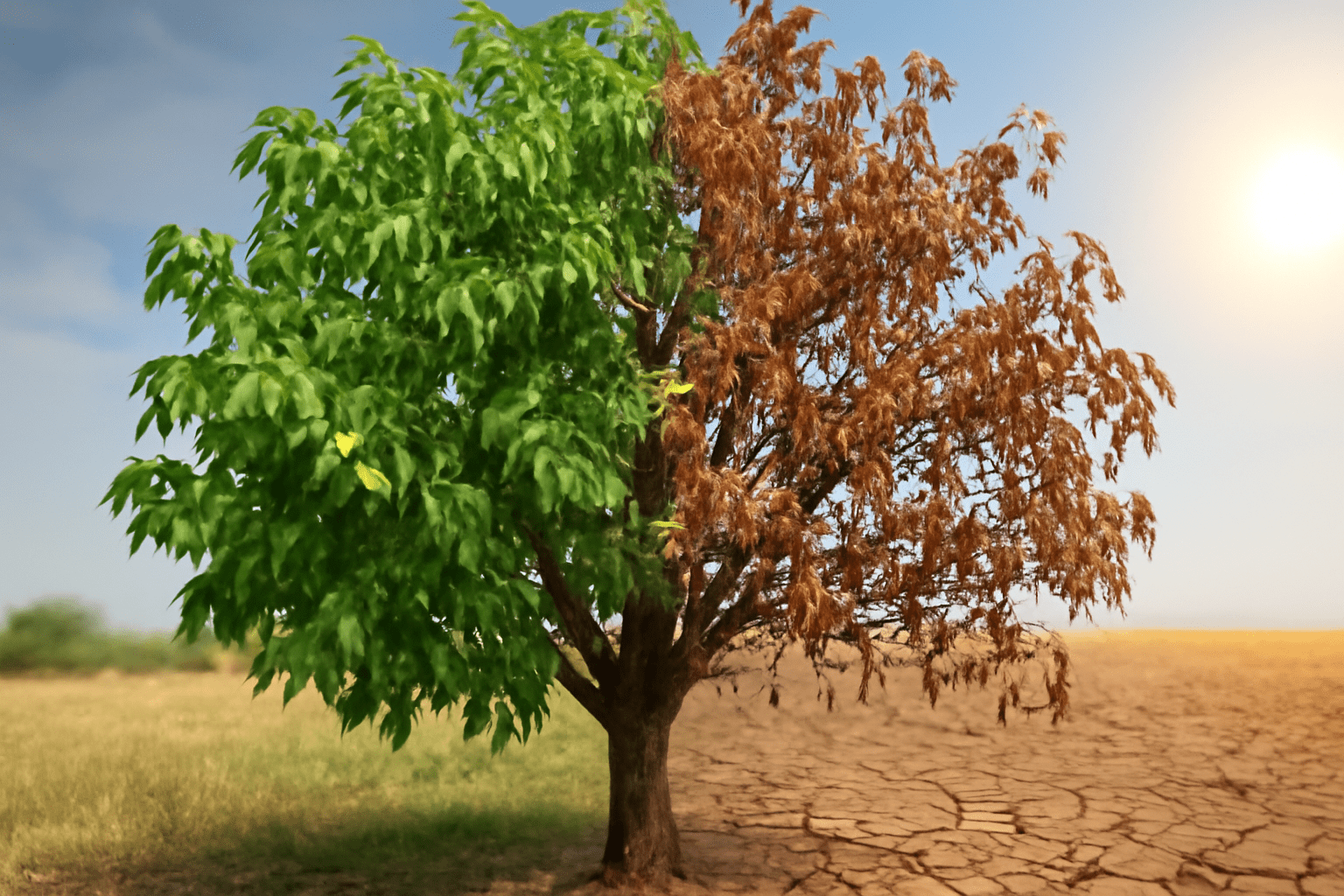
For instance, English walnut trees 🌰 are generally more reliable than black walnut trees 🌳, which may produce more sporadically.
Check the variety of your tree and consult with local experts to understand the typical production habits for that specific species. 🌿
🌱 Why Do Walnut Trees Skip a Year? 🌱
There are several reasons why your walnut tree might not produce nuts in a given year. Here are some common causes:
🍂 Overproduction in the Previous Year:
Some walnut trees go through “alternate bearing” 🌱, meaning they produce a heavy crop one year and a light or no crop the next. This is natural and happens when the tree’s resources are depleted after producing a large amount of fruit. In such years, the tree needs time to recover, which can result in a skipped production year.
🌞 Stress Factors:
Environmental stressors like drought 🌵, excessive rainfall 🌧️, or extreme temperatures 🌡️ can cause walnut trees to take a break from producing nuts. This is the tree’s natural defense mechanism. 🌳
✂️ Improper Pruning:
Pruning at the wrong time or cutting too much ✂️ can damage the tree and reduce its ability to produce nuts. Prune carefully and at the right time 🕰️ to encourage healthy growth. 🌿
🌿 How to Encourage Annual Walnut Production 🌿
If you want your walnut tree to produce nuts every year, here are a few tips to help:
💧 Provide Consistent Care:
Water your tree regularly 🌊, especially during dry spells. Walnuts require consistent moisture during the growing season to thrive. 🌞
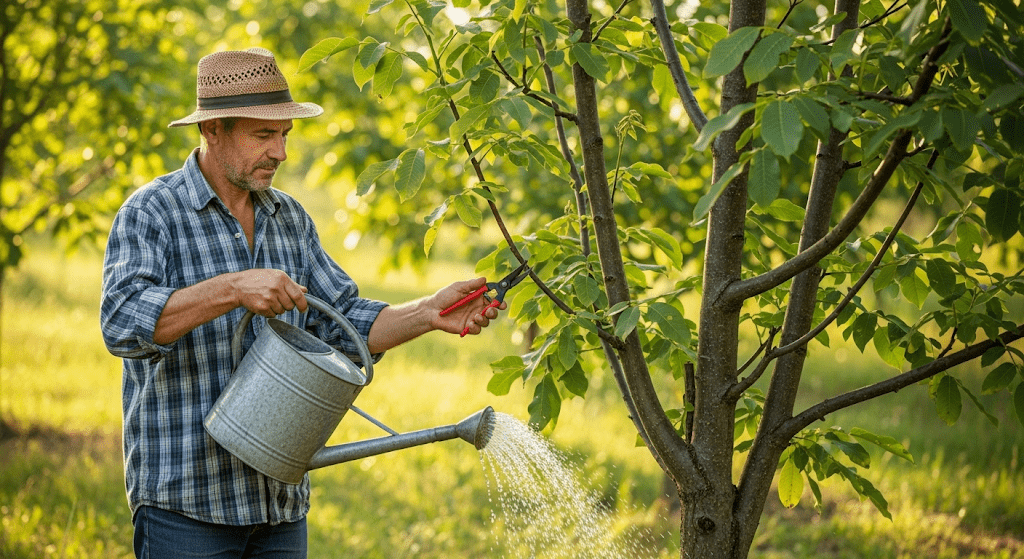
Fertilize with a balanced fertilizer 🥄 to ensure your tree has the nutrients it needs to produce fruit. Pay attention to soil quality 🌾 and amend it if necessary.
🌞 Minimize Stress:
Protect your tree from extreme weather 🌬️ by providing frost protection during early spring ❄️ and ensuring it gets enough water during dry periods.
If you notice signs of pests 🐞 or diseases, address them immediately to avoid any damage to the tree. 🛡️
🌸 Ensure Proper Pollination:
Plant more than one walnut tree 🌳 to ensure cross-pollination, especially if you have a single tree.
Be mindful of the timing of pollination ⏰—late spring frosts ❄️ can damage flowers, so monitor weather conditions closely.
✂️ Prune Carefully:
Prune walnut trees in late winter or early spring before the new growth begins 🌿. Avoid heavy pruning during the growing season, as it can harm the tree and affect its fruit production. 🌱
By understanding the reasons behind irregular walnut production and taking the necessary steps to care for your trees, you can increase the likelihood of getting a bountiful harvest year after year. 🌳🌰 With patience and proper care, your walnut trees will reward you with delicious nuts for years to come! 😊
🌰 Maximizing Walnut Harvests 🌰
Growing walnut trees is a rewarding experience, but to ensure you get the most out of your trees, it’s essential to take a few key steps to maximize your walnut harvest. Whether you’re a seasoned gardener 🌱 or a newbie 🌿, these actionable tips will help you boost your tree’s production and ensure the nuts are of the highest quality. Let’s dive into some expert advice on how to get the best yield from your walnut trees! 🌳

🌿 1. Improving Soil Health for Better Yields 🌱
The foundation of a great walnut harvest starts with healthy soil. Here’s how to optimize your soil for maximum nut production:
- Soil Testing: Before you begin planting, test your soil for pH levels and nutrient content. Walnuts prefer slightly acidic soil with a pH of 6–7. 🧑🔬
- Amend the Soil: If your soil is lacking in nutrients, add organic compost 🌾, well-rotted manure 🐄, or a balanced fertilizer 🌱 to improve soil health. This provides essential nutrients like nitrogen, phosphorus, and potassium, all of which are crucial for healthy walnut production.
- Mulching: Use mulch 🍂 around the base of the tree to retain moisture 💧, regulate soil temperature 🌡️, and improve soil structure. This also helps to suppress weeds 🌿 that compete with your tree for nutrients.
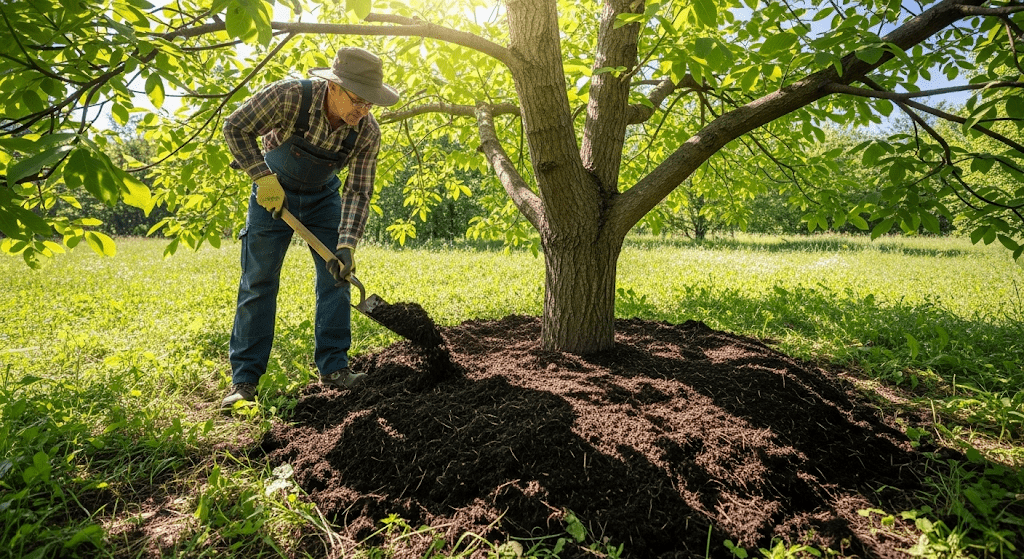
🌿 2. Watering for Healthy Growth 💧
Walnut trees need a consistent supply of water 💦 to grow strong and produce nuts 🌰. However, overwatering can be just as damaging as underwatering. Here’s how to get it right:
- Regular Watering: Water your tree deeply during dry spells, especially during the growing season when the tree is developing nuts. Aim for about 1–2 inches of water per week. 💧
- Proper Drainage: Make sure your walnut tree is planted in well-draining soil 🌱 to prevent root rot. Poor drainage can stress the tree and stunt growth. 🌳
- Watering During Flowering: Adequate moisture is especially important during the flowering and nut-setting stages in spring and early summer 🌸. Without sufficient water, walnut trees may drop their nuts prematurely. 🍂

🌿 3. Pruning to Promote Healthy Growth ✂️
Pruning is essential for maintaining a healthy walnut tree that produces abundant fruit 🍏. But it’s important to do it at the right time and in the right way:
- Timing: Prune your walnut trees during the dormant season (late winter to early spring). This minimizes the risk of disease 🦠 and ensures the tree is ready for the growing season.
- Proper Techniques: Focus on removing dead or damaged branches 🌿, and thin out crowded areas to allow better air circulation 🌬️ and sunlight penetration 🌞. This helps improve the tree’s overall health and ensures the nuts develop properly.
- Avoid Heavy Pruning: Too much pruning can stress the tree and reduce its nut-bearing potential. Only remove what’s necessary to encourage strong growth. 🌱
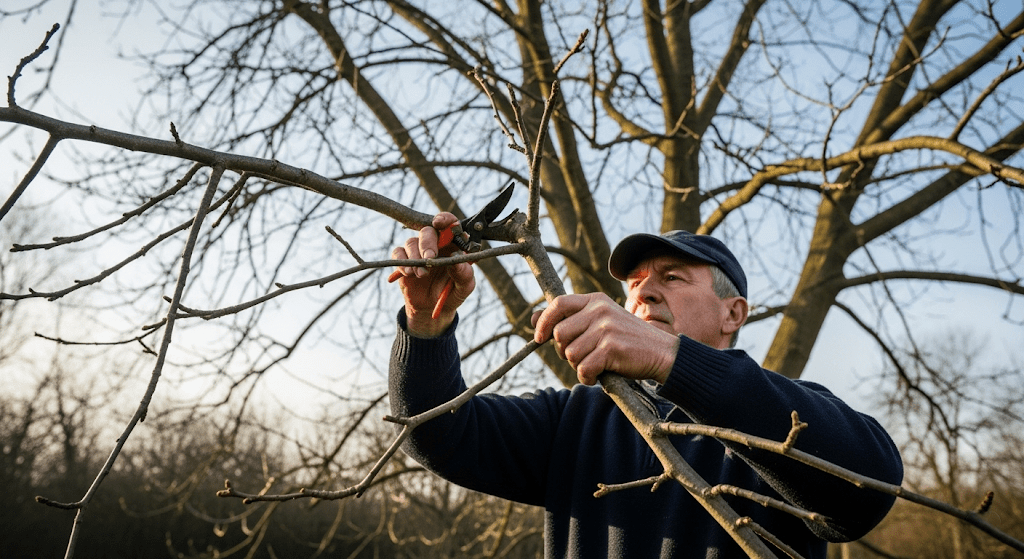
🌿 4. Protecting Your Walnut Trees from Pests and Diseases 🐜
Healthy walnut trees are more likely to produce a good harvest 🌰, so it’s essential to protect them from pests 🐞 and diseases 🦠:
- Pests to Watch For: Common walnut pests include walnut husk flies 🦋, aphids 🐜, and caterpillars 🐛. These pests can damage the tree and the nuts, so regular inspection 🧐 is important.
- Disease Prevention: Fungal diseases like walnut blight 🦠 can affect both the tree and the nuts. To prevent disease, ensure proper air circulation 🌀 around the tree and avoid overwatering. Apply fungicides if necessary, and remove any infected branches. ✂️
- Natural Predators: Encourage beneficial insects like ladybugs 🦗 and lacewings 🦋, which naturally control pest populations without harming your tree.

🌿 5. Fertilizing to Boost Production 🌾
Proper fertilization helps your walnut tree grow stronger 💪 and produce more nuts 🌰. Here’s how to fertilize effectively:
- Balanced Fertilizer: Use a balanced fertilizer 🌿 with equal parts nitrogen (N), phosphorus (P), and potassium (K). This will ensure that the tree receives all the nutrients it needs to grow and produce fruit. 🍏
- Timing: Fertilize your walnut tree in early spring 🌷 before new growth starts, and again in late summer or early fall 🍁 to help the tree prepare for the next season.
- Avoid Over-Fertilizing: Too much nitrogen can result in excessive leaf growth 🌿 and fewer nuts 🌰. Be sure to follow the recommended dosage on your fertilizer package 📦.
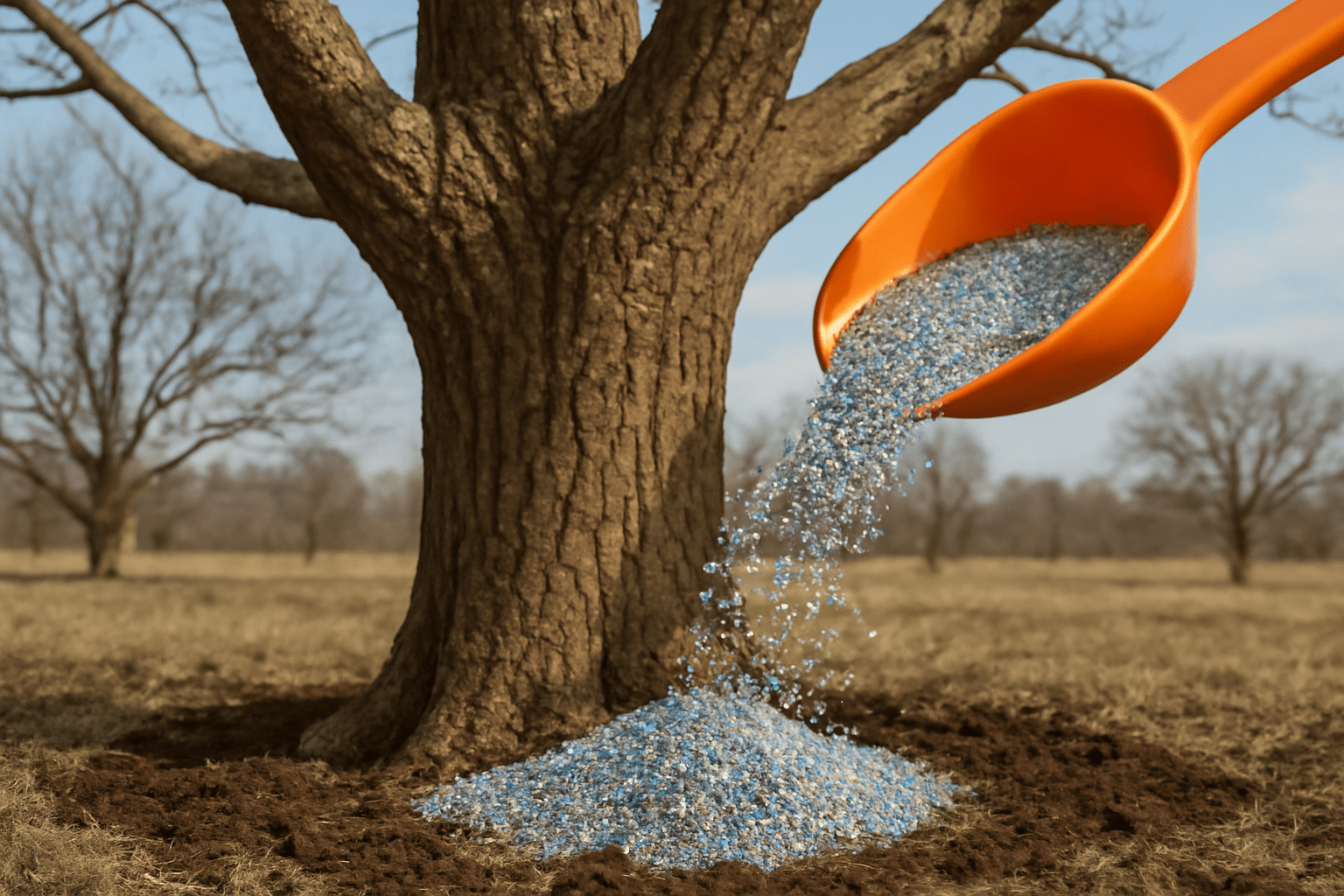
🌿 6. Timing the Harvest for Maximum Quality 🍂
Harvesting your walnuts at the right time ⏰ is crucial for maximizing their quality 🌟 and shelf life. Here’s what to look for:
- Signs of Ripeness: Walnuts are ready to harvest when the outer husk begins to crack and the nut inside rattles when shaken 🎶. The husk will typically turn brown 🍂 and fall off easily when ripe.
- Timing: Harvest your walnuts in late summer to early fall 🍁. Waiting too long to harvest can lead to the nuts falling off prematurely or being damaged by pests 🐛.
- Storage: After harvesting, allow the walnuts to dry in a cool, well-ventilated area 🏠 for a few weeks. Once dry, store them in a cool, dark place 🌑 to prevent spoilage.

🌿 7. Growing Walnuts in Small Spaces or Containers 🏡
If you don’t have a large garden but still want to grow walnuts 🌰, it’s possible to grow them in smaller spaces or even containers 🪴:
- Dwarf Varieties: Choose dwarf walnut tree varieties 🌱, which are smaller and can thrive in containers or small gardens. 🌳
- Container Tips: Ensure your container is large enough to accommodate the tree’s root system 🌱 and has proper drainage 💧. Regularly check the soil moisture 🌿 and fertilize as needed.
- Pollination: Even in smaller spaces, you’ll still need at least one other walnut tree 🌳 for proper pollination.

By following these tips, you’ll be well on your way to maximizing your walnut harvest. Healthy soil 🌱, proper watering 💧, careful pruning ✂️, pest control 🐜, and timely harvesting ⏰ are all essential to ensuring that your walnut trees bear fruit year after year. With patience and care 💪, your walnut trees will thrive 🌳, providing you with delicious, home-grown nuts 🌰 for many seasons to come! 😊🌳
🌰 Final Thoughts 🌰
Growing walnut trees 🌳 can be a rewarding and fulfilling experience, but it requires patience ⏳, attention to detail 🔍, and a solid understanding of the factors that influence production. By following the tips and insights shared in this article 📚, you can maximize your walnut harvest 🌰 and ensure your trees remain healthy 🌿 and productive for years to come. 🌳

Remember, walnut trees 🌰 might not produce every year due to a variety of factors like age 🌱, climate 🌦️, pollination 🌸, and tree health 🌳. However, with proper care 💧, you can increase the chances of a consistent, bountiful harvest 🍂. Whether you’re a beginner 🪴 or an experienced gardener 🌻, the key to success lies in providing the right conditions for your walnut trees 🌳 to thrive.
So, get ready to nurture your trees 🌱, be patient ⏳, and soon enough, you’ll be enjoying the fruits of your labor—delicious, home-grown walnuts 🌰! 😊 Happy gardening! 🌿
🌰 Frequently Asked Questions (FAQs) 🌰
Do walnut trees produce nuts every year?
No, walnut trees do not produce nuts every year. They may skip a year due to various factors like age, environmental stress, or poor pollination. However, with proper care, they can produce regularly after a few years of growth.
How long does it take for walnut trees to start producing nuts?
Walnut trees typically start producing nuts in about 5-7 years if they are grafted, and 10-15 years if grown from seed. Patience is key, as younger trees need time to mature before they can bear fruit.
What causes walnut trees to not produce every year?
Factors such as age, weather conditions (like frost or drought), poor pollination, and tree health issues (diseases or pests) can prevent walnut trees from producing every year. Some trees also experience “alternate bearing,” where they produce a heavy crop one year and a light crop the next.
How can I encourage my walnut tree to produce every year?
To encourage yearly production, provide consistent care, including proper watering, pruning, and fertilization. Ensure good pollination by planting more than one walnut tree and protect the tree from pests and diseases.
Why did my walnut tree produce a lot of nuts one year but very few the next?
This is likely due to “alternate bearing,” a natural cycle in walnut trees where they produce a heavy crop one year and a lighter one the next. Stress factors, such as weather conditions or overproduction, can also contribute to this pattern.
What are the best growing conditions for walnut trees?
Walnut trees thrive in well-drained, slightly acidic soil (pH 6–7) and need a temperate climate. They require full sun and consistent moisture, especially during the growing season, to ensure healthy growth and nut production.
Do walnut trees need another tree for pollination?
Yes, walnut trees are not self-pollinating. They need another walnut tree nearby for effective cross-pollination. Planting at least two trees will improve pollination and increase the chances of a good nut crop.
Can walnut trees be grown in containers?
Yes, dwarf varieties of walnut trees can be grown in containers. However, they need large pots with good drainage, regular watering, and proper fertilization. Keep in mind that container-grown trees may have reduced yields compared to those planted in the ground.
